
The Angry Photographer – Magnetic Field
Arc Blast – Part Three
By Andrew Hall
In Part One of this series, we looked at how arc blast creates a mountain. We examined triangular buttresses on mountainsides and how they conform precisely with the characteristics of reflected shock waves. In particular, we looked at layering, compression and expansion of the wave-forms.
In Part Two, we looked at evidence of harmonics, wave-form instabilities and boundary layer effects that are imprinted on the landscape.
In this article, we’ll take a closer look at layering and electromagnetic influences.
Electromagnetic Effects . . .
The stratified layers of triangular buttresses are often segregated by mineral composition. This is evidence of electromagnetic forces. The arc flash that creates the mountain is essentially a lightning bolt, traveling in an ionized double layer in the atmosphere. An electric field will ionize particles. A magnetic field will sort them. An arc flash necessarily has an electromagnetic field surrounding it.
In fact, the arc is just the intense current flow of electrons at the core of the electromagnetic field. The field itself expands away from the core with the shock wave.
The shock waves are energized with current. The shock wave is a highly stressed region – a dramatic shear zone of pressure, density and temperature the ionized winds can’t penetrate. Ionized material flows with the winds in the low stress triangular region between the shock waves. The shock wave itself is a conduit for current. Current coursing through thin shock waves molds the electromagnetic fields in the coherent form of the reflected shock and sorts material according to its dielectric properties.


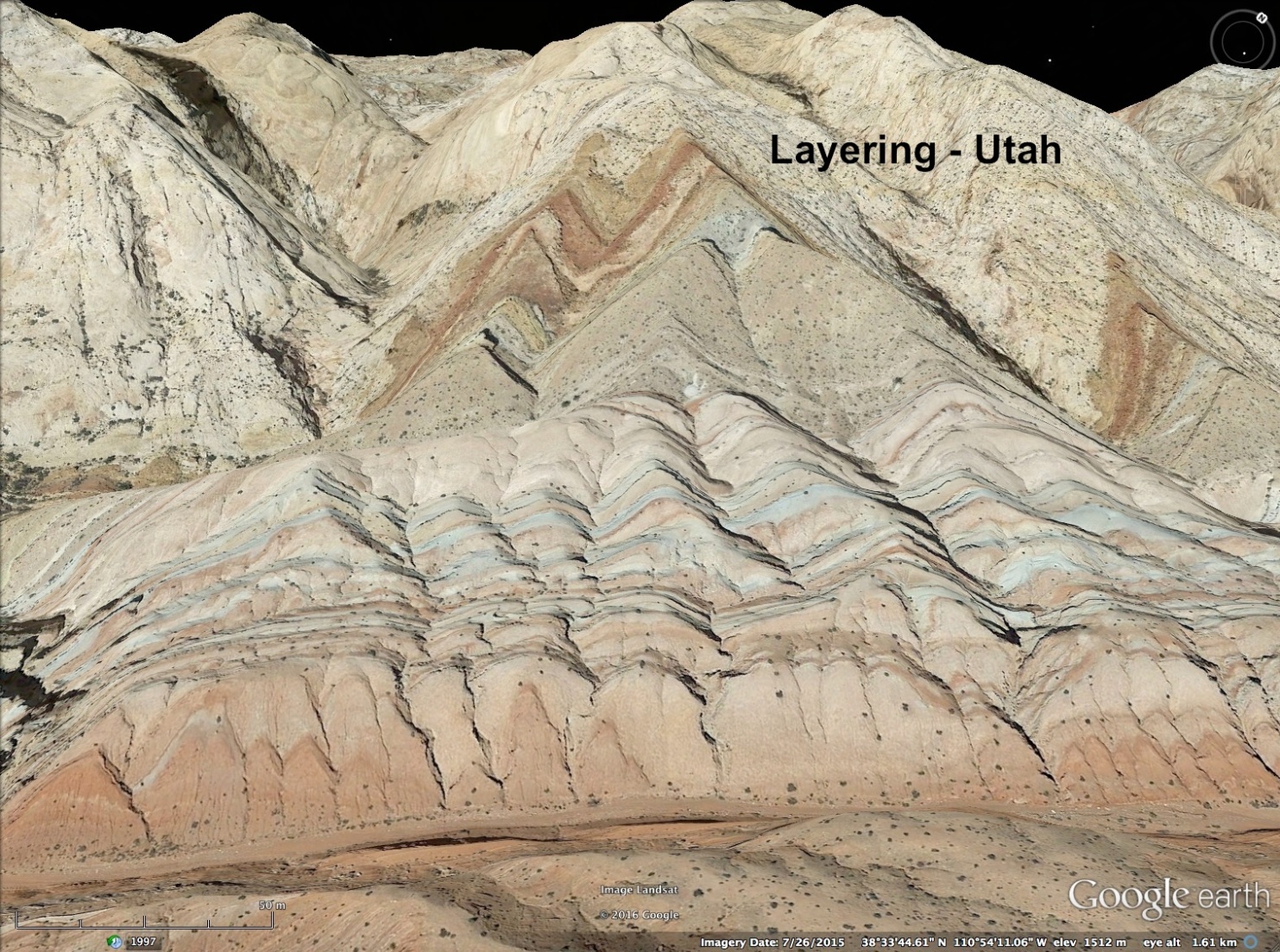
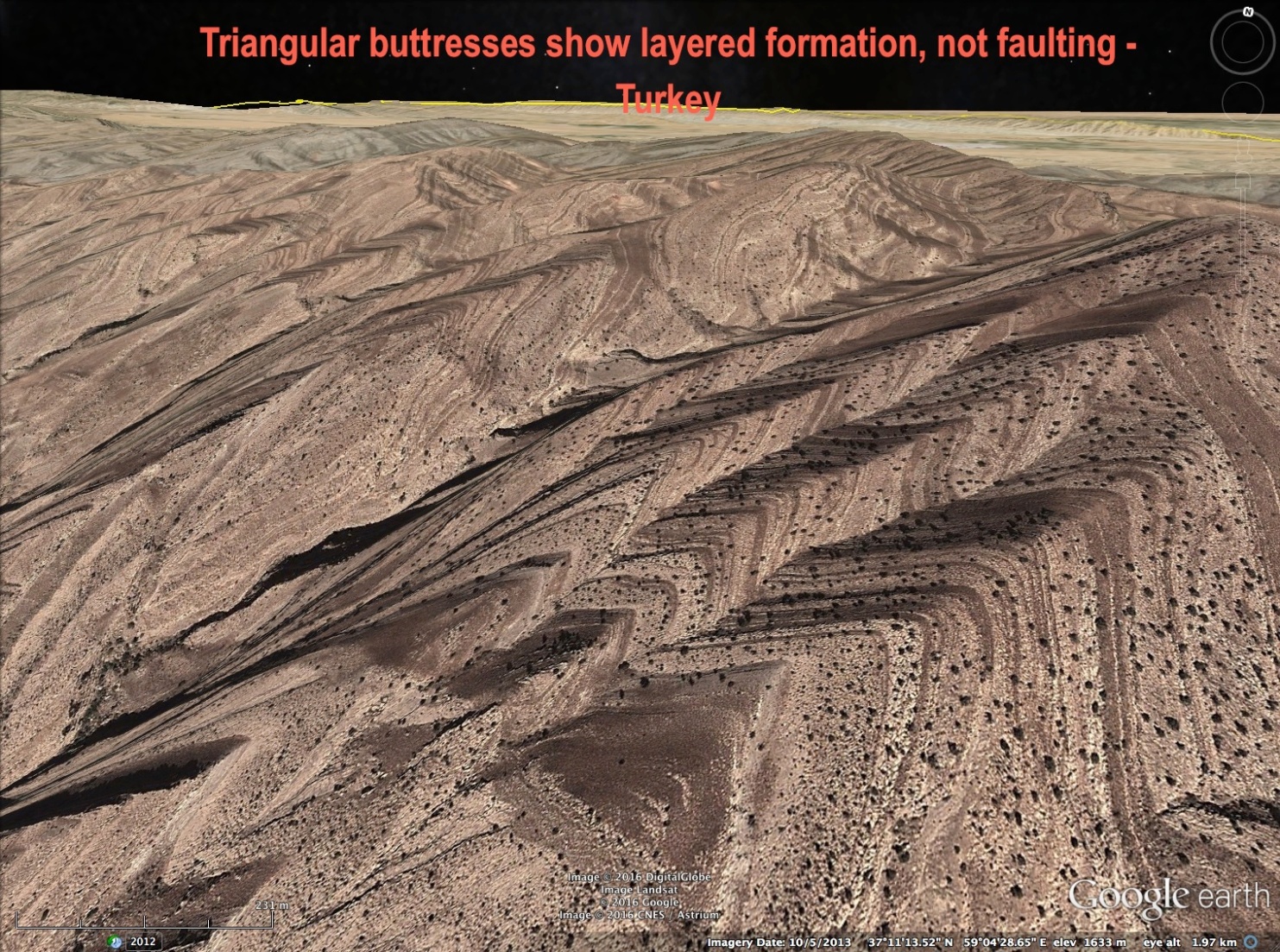
Blowouts . . .
Another dramatic signature of an electrical nature is a feature called a “blowout.” Blowout occurs when the arcing current makes direct contact with the ground.
The arc flash follows the most conductive path available. It travels in the ionized atmosphere, especially in arid regions where soils are dry and non-conductive compared to the ionized atmosphere above ground. When a conductive surface feature is available, the arc will fork to ground.
The conductive feature may be a mineral deposit, or water in a stream, aquifer or wetland. The result is a crater that blasts away a portion of the mountain being formed. The images below show a blowouts in the center of a mountain. It is apparent the crater significantly modified the form of the mountain.



Expansion Fans . . .
The images to f ollow are from a complex formation of astroblemes in Iran. They are on the outside, or convex bend, in a large mountain arc.
ollow are from a complex formation of astroblemes in Iran. They are on the outside, or convex bend, in a large mountain arc.
One unusual crater shows shock effects as the apparent arc trajectory changes. The feature annotated is an example of an expansion fan, which is a set of reflected waves that occur on the outside of a bend (convex) when the source of the shock makes a change in direction. The fanning shock waves have produced linear hills that radiate from the bend.
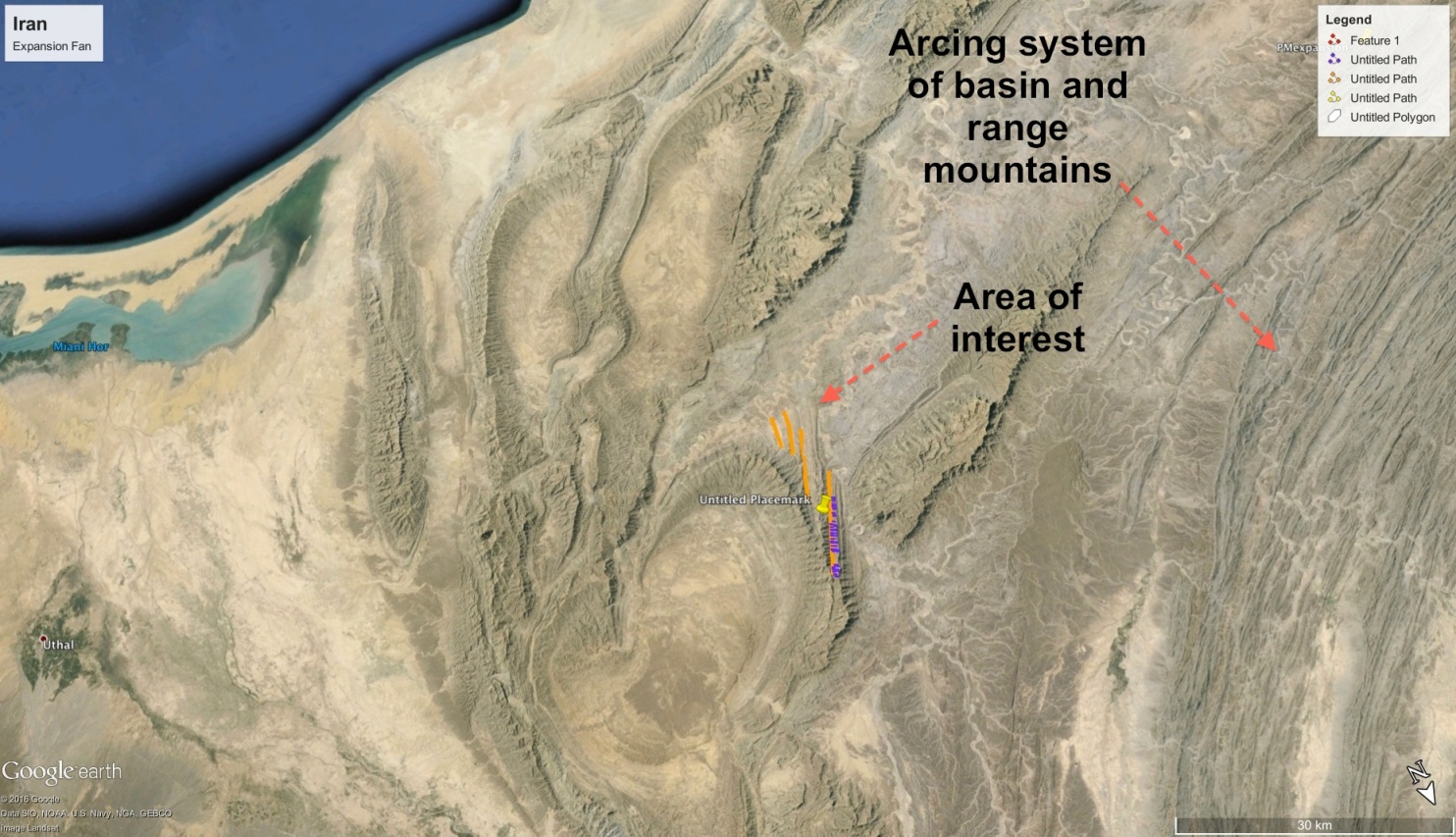
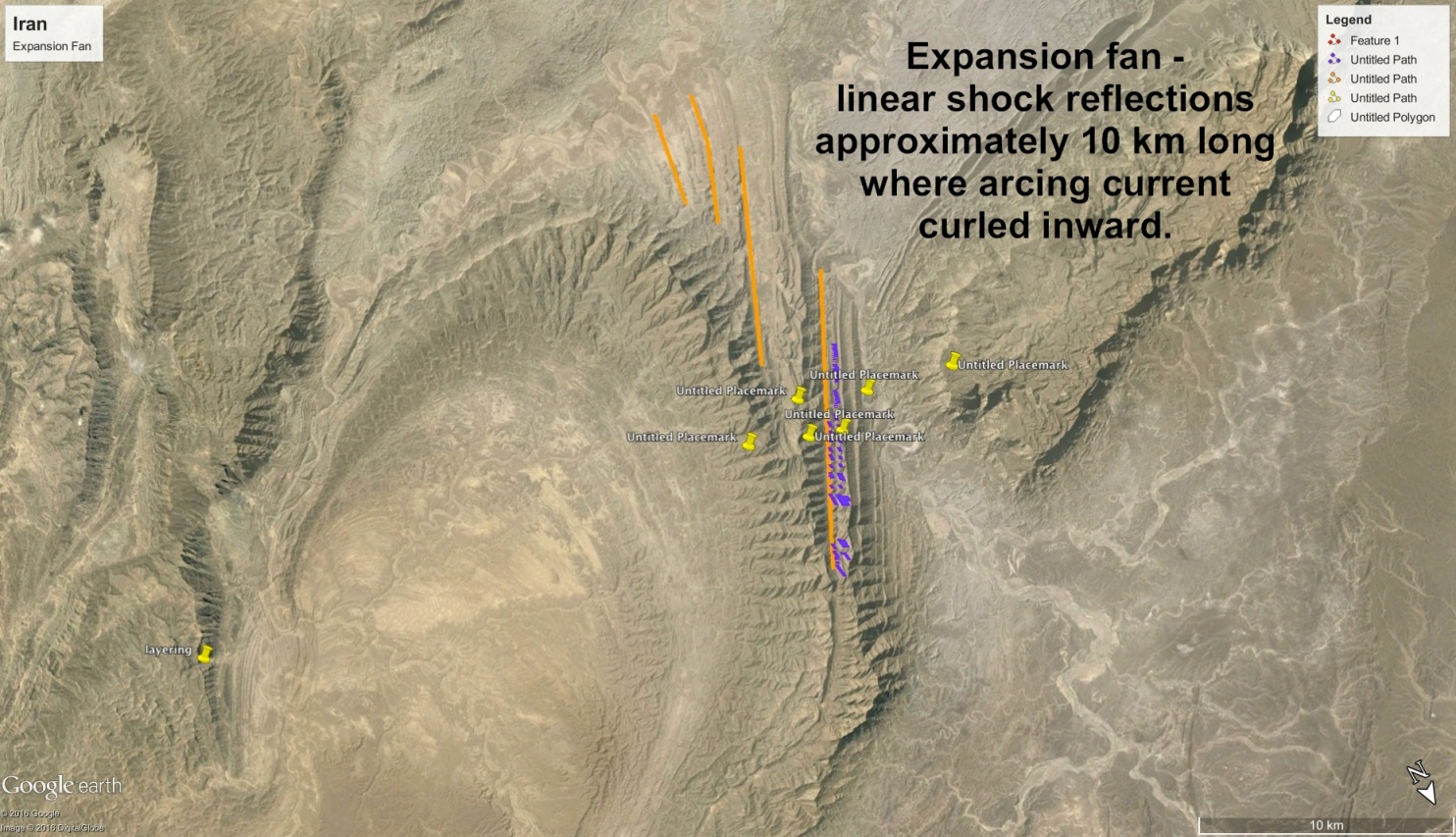




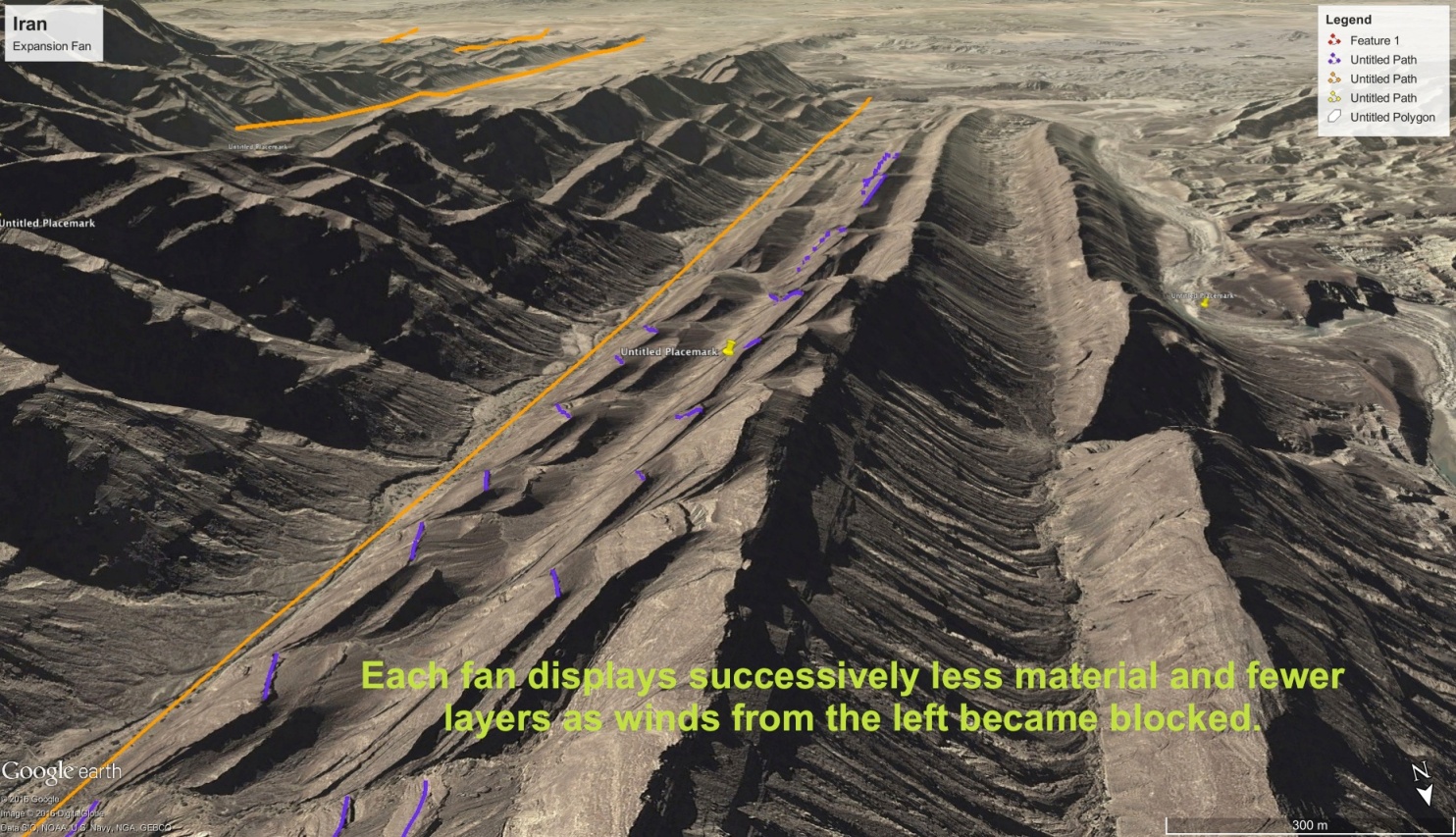
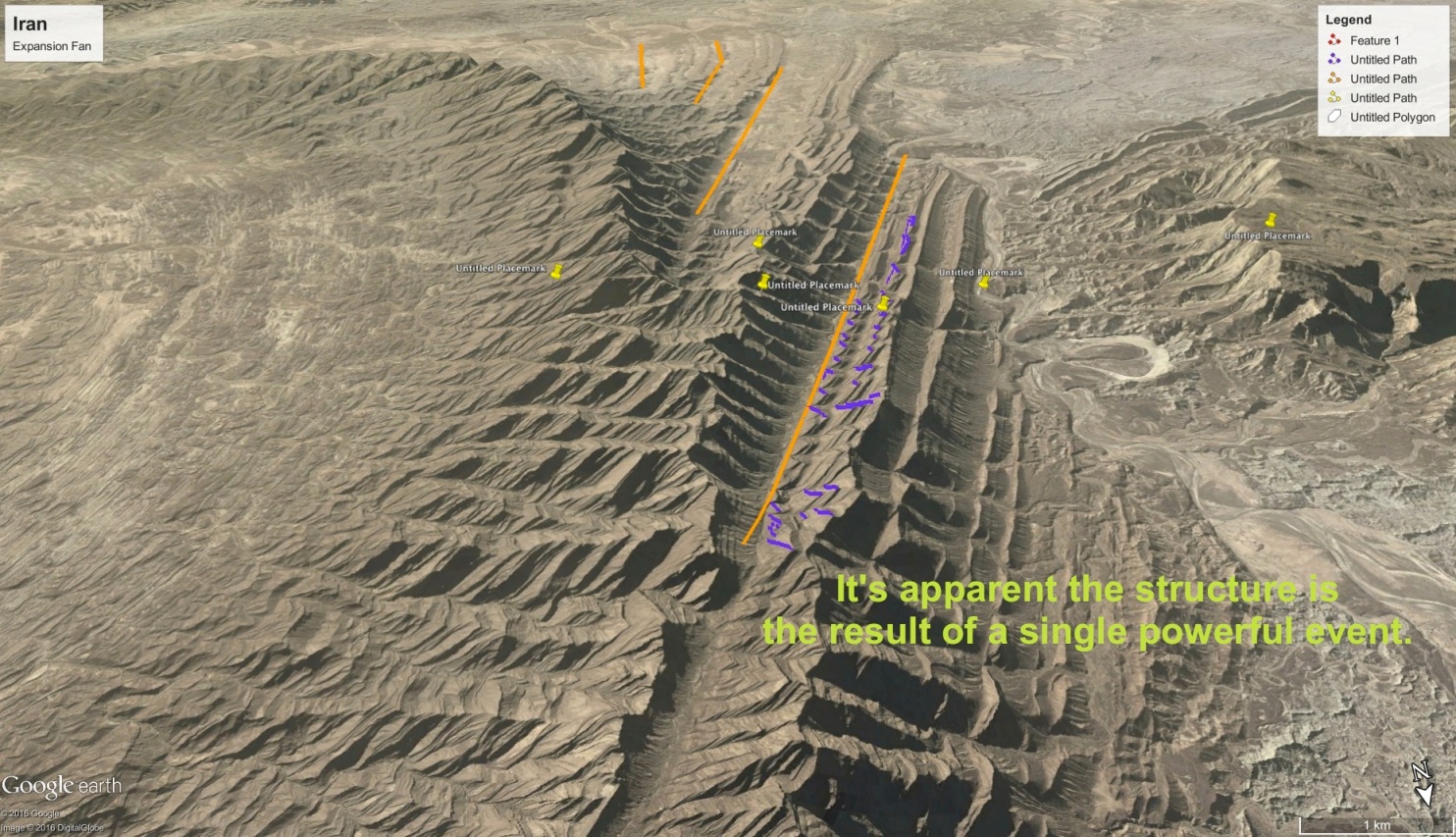

Ejecta and Ablation Zones . . .
Material ablated from the blast forms layered hills and pressure ridges on the surrounding area. Layering indicates material was blown away from the blast, instead of being drawn toward it by the suction of the mushroom cloud. Evidence of high speed winds is seen where they form fingers of conical flow, dunes and pressure ridges.
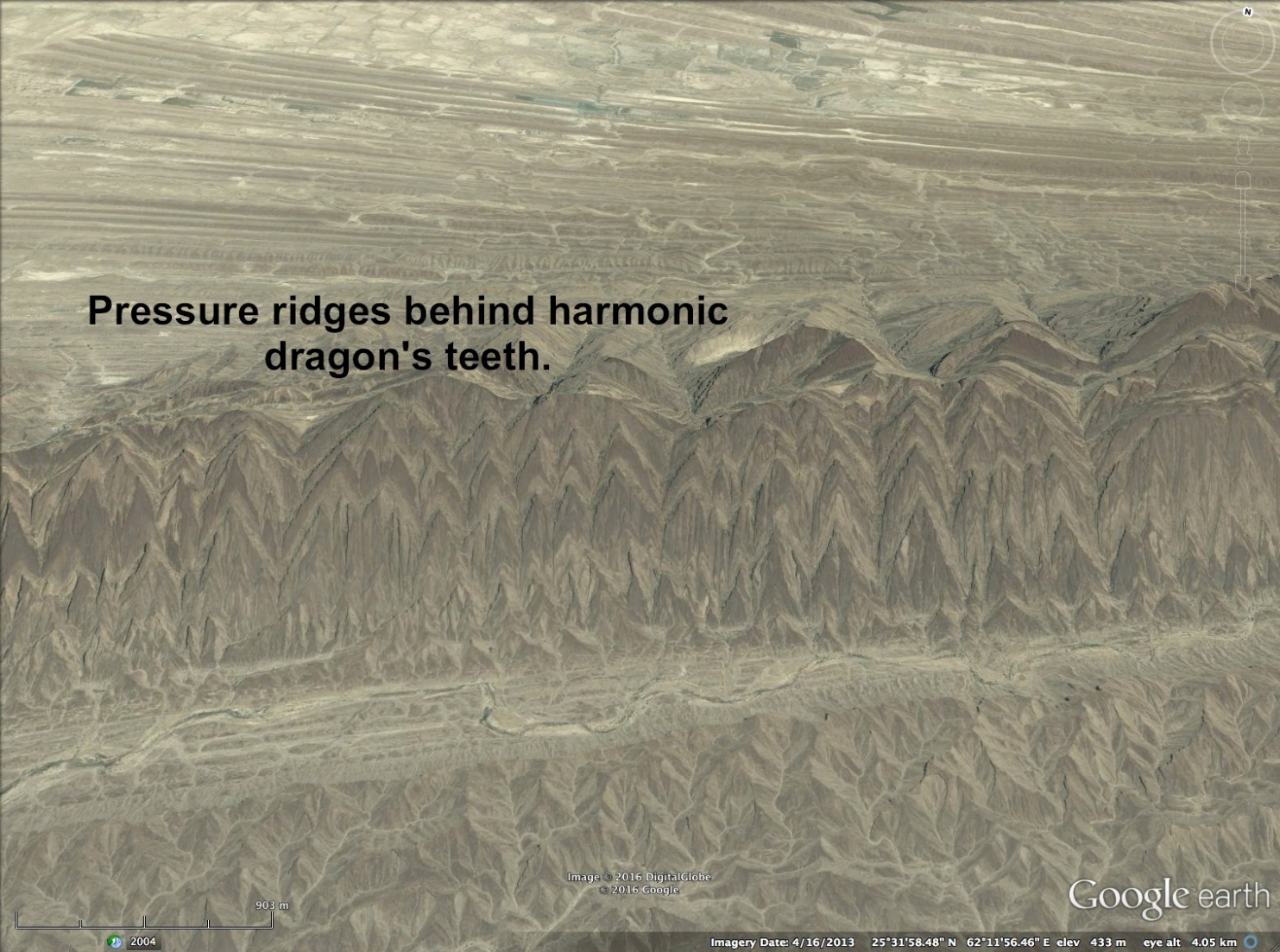
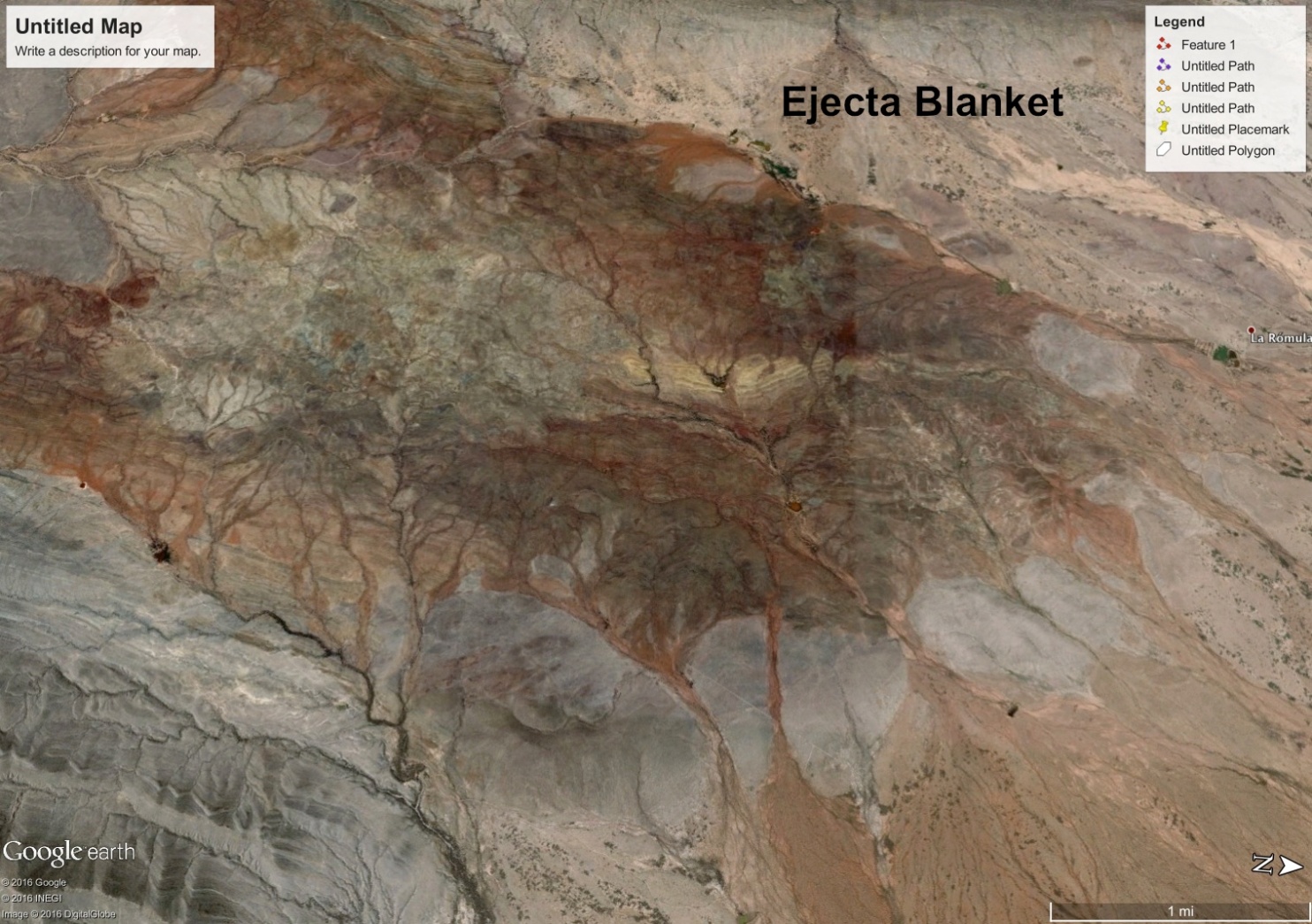


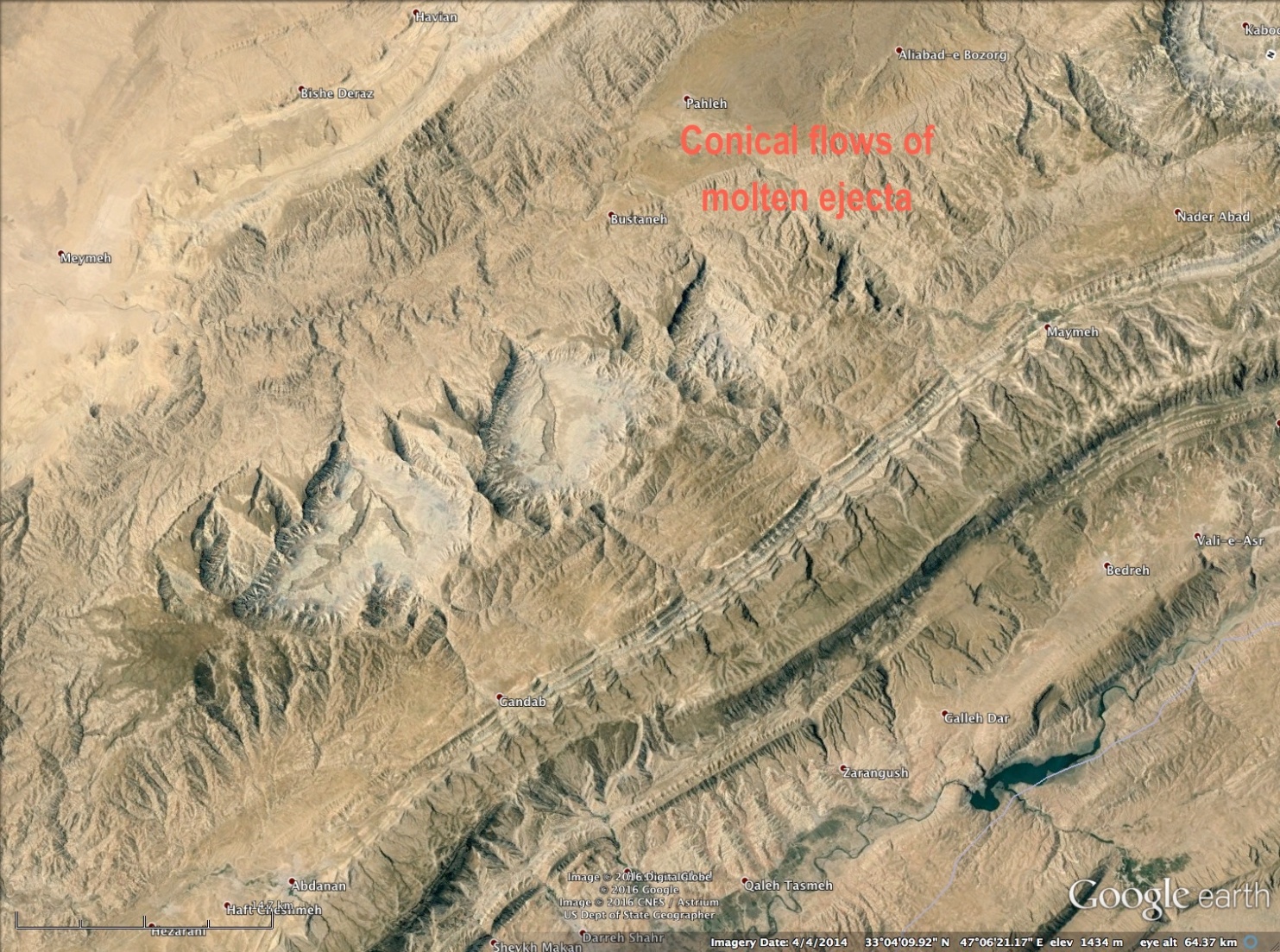
Summary. . .
Let’s recap what we have seen:
- Triangular buttresses form on the sides of mountains in the shape of reflected supersonic shock waves.
- They are layered onto the mountain; so, they are not caused by seismic waves.
- They are not layered sediments from an ancient beach, or waterway since the sharply angled triangles are a consistent feature around the world and do not conform to any motion of random water waves.
- They are formed in all types of rock, including granite; so, they are not formed by eons of normal winds.
- The triangular wave-forms exhibit compression and expansion from superimposed longitudinal and transverse waves.
- The triangular wave forms exhibit harmonic repetition consistent with reflected shock waves.
- The triangular wave-forms exhibit super-positioning and cancellation under compression consistent with reflected shock waves.
- The triangular wave-forms are parallel to the primary shock pattern, consistent with reflected shock waves and perpendicular to the wind direction, consistent with supersonic winds created by a shock wave,
- The triangular wave-forms exhibit less energy and more transient effects on softer substrates, and higher energy and sharper, more defined angles on hard substrates.
- Triangular wave-forms exhibit transient reflections, normal shocks and features of density variation consistent with supersonic reflected shock waves.
- The blast zones show concentric rings of pressure ridges, layered in the direction of the winds.
- The winds within the blast zone are directed normal to the central mountain, or crater (outward blown winds,) as indicated by surface layering on pressure ridges and buttresses.
- Boundary layer features of reflected waves can be found in the substrate of the blast zone as seen in the road cut in Iran.
- Land surrounding the blast zone is blanketed with ejecta that exhibits flow patterns from high speed winds.
This concludes the Arc Blast series of articles on reflected shock waves and their significance. Future articles will examine more evidence for the effects of arc flash on the landscape:
- The ‘rooster tail’ and how big mountains are built
- Following winds and how Kelvin-Hemholtz instability can modify a mountain ridge
- Complex mountain forms and mountain arcs
- The interrelation between volcanoes and mountains
- The connection between shock waves, fractals and Lichtenburg landscapes
- How rocks form
- The cause and nature of an arc flash
- Sub-sea canyons, trenches and rifts
- Examples from the archaeological and mythological records of mankind
What is proposed here can be verified. In fact, mountains are the most tangible evidence for the Electric Universe model available. The evidence is under our feet. There are already reams of geologic data waiting to be re-interpreted. Geophysics, applied to evaluate geology as the consequence of electromagnetic and hydro-dynamic forces, will some day bear this out. You may even have the ability to bring that day closer. Your comments are invited.
Additional Resources:
Surface Conductive Faults | Thunderblog
Arc Blast — Part One | Thunderblog
Arc Blast — Part Two | Thunderblog
YouTube Playlists through 4-2022:
Andrew Hall — EU Geology and Weather
Andrew Hall — Eye of the Storm Episodes (13)
Andrew Hall is an engineer and writer, who spent thirty years in the energy industry. He was a speaker at the EU2016 conference and can be reached at hallad1257@gmail.com or https://andrewdhall.wordpress.com/
Disclosure: The proposed theory of arc flash and arc blast and their effects on the landscape are the sole ideas of the author, as a result of observation, experience in shock and hydrodynamic effects, and deductive reasoning. Dr. Mark Boslough’s simulation of an air burst meteor provided significant insight into the mechanism of a shock wave. His simulation can be viewed on YouTube: Mark Boslough. The author makes no claims that this method is the only way mountains or other geological features are created.
The ideas expressed in Thunderblogs do not necessarily express the views of T-Bolts Group Inc or The Thunderbolts ProjectTM.












